Crested geckos (Correlophus ciliatus) are small-to-medium geckos native to New Caledonia.
They are also sometimes called eyelash geckos because of the soft crests over their eyes. They are only found on two islands and have only three populations in the wild.
They are considered threatened in the wild, so you should only buy a captive-bred animal. Thankfully, they are incredibly common in the pet trade and you can find many breeders.
They are very well-understood and are great beginner geckos since they are fairly hardy for their size.
This guide will teach you everything you need to keep a healthy and happy crested gecko.
Once you master primary care, there is also a short section on how to breed crested geckos and how to care for fresh hatchlings.
- Housing
- Feeding
- Shedding
- Hibernation
- Breeding
- Handling
- Frequently Asked Questions
- Do Crested Geckos Like to be Held?
- Does a Crested Gecko Make a Good Pet?
- How Hard is it to Care for a Crested Gecko?
- How Big do Crested Geckos Get?
- Do Crested Geckos get Attached to Their Owners?
- Are Crested Geckos Friendly?
- Is it Easy to Care for a Crested Gecko
- How long does a crested gecko live?
- Where to Buy a Crested Gecko?
- Sources
- Conclusion
Housing
The goal of housing your crested gecko is to meet all of its physical needs.
This means you need to provide a secure enclosure that allows your gecko to thermoregulate and exercise.
Your gecko should feel safe in its enclosure and have all its needs met.
Enclosure
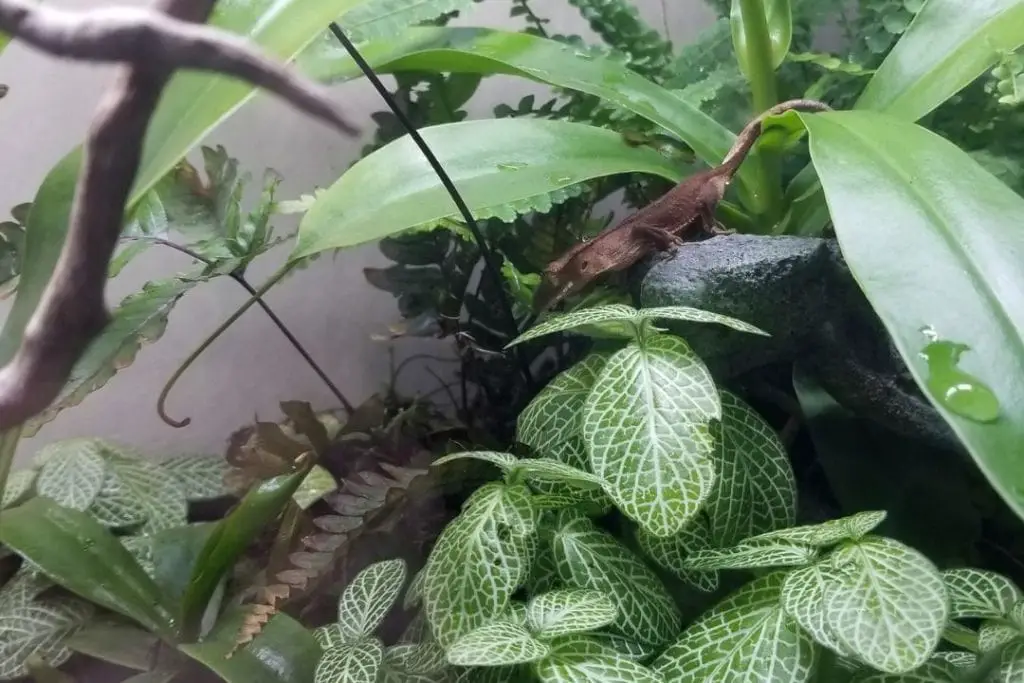
An enclosure for a crested gecko does not need to be very long, but it should be tall.
Crested geckos like to climb, so they need vertical space and an enclosure tall enough to offer a vertical thermal gradient.
They need higher humidity than most homes will have, but heating is easy since they need temperatures just slightly higher than average room temperature.
Make sure your enclosure holds humidity and has a good locking door that will keep your gecko secure.
Enclosure for Baby & Juvenile Crested Geckos
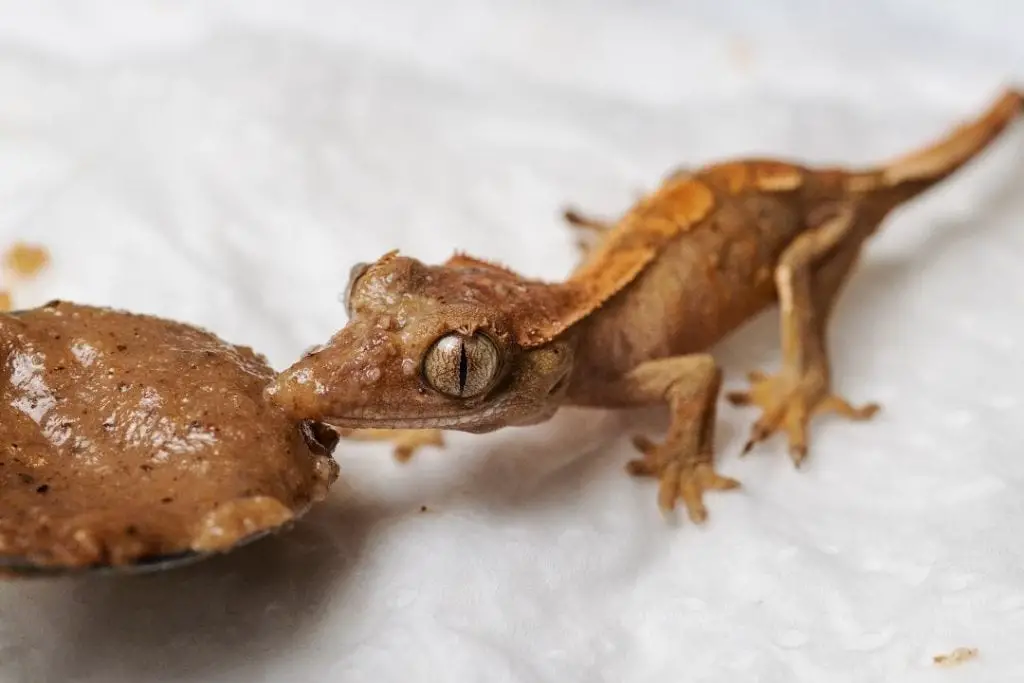
Crested geckos that weigh under 12 grams need to be in a smaller enclosure. Small geckos can have difficulty finding their food in big enclosures. Baby crested geckos can also be stressed from too much space.
You should use an 8″x8″x12″ enclosure around 5 gallons. This gives 12 inches in height which lets your gecko have more space to climb.
The reptizoo enclosure is recommended.
It has a front-opening door that will help keep your gecko from being stressed out by being approached from above.
It also has a screen top that won’t block UVB and feeding holes so you don’t need to open the door and risk an escape from a flighty baby.
Enclosure for Adult Crested Geckos
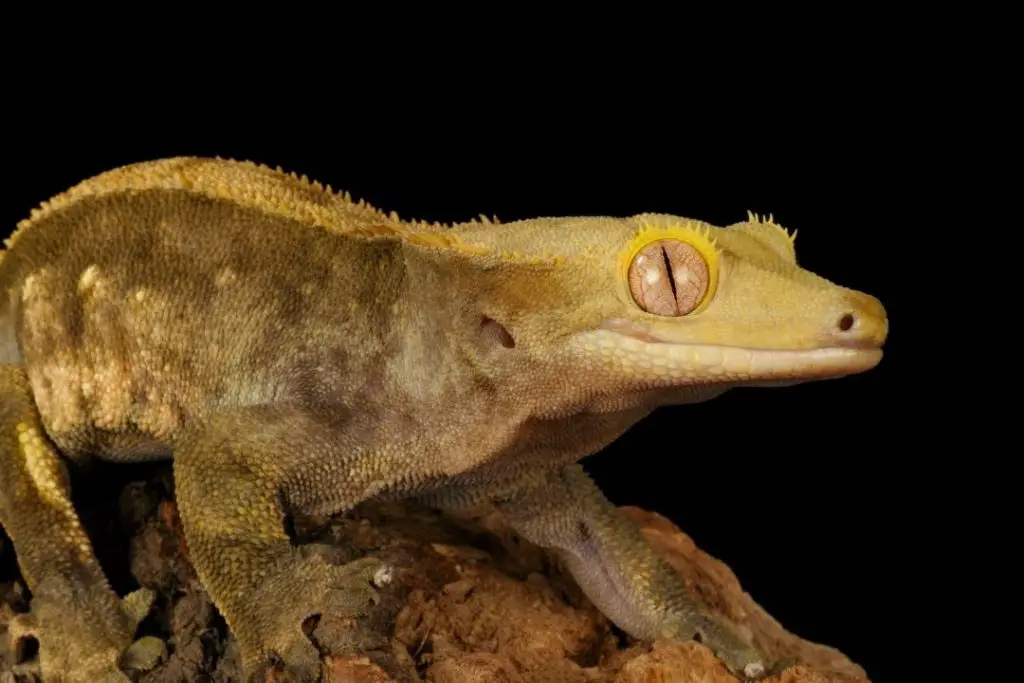
An adult needs a much larger enclosure. You can move your gecko to its adult enclosure as early as 10 grams of weight, but you will need extra feeding platforms and more clutter for smaller geckos.
A single adult needs a minimum of 20 gallons. This makes the minimum size 18″x18″x24″. Remember, the largest measurement should be the height.
A 18X24X24 from REPTIZOO is a good choice thanks to the front-opening doors and a screen top. One thing to note is that glass doesn’t hold humidity very well.
The solid sides also help your gecko feel less exposed. You can house a breeding group or a group of female crested geckos. You need at least 5 extra gallons for each gecko.
Male crested geckos will kill each other, so never house them together. Never house a male and female unless you intend to breed them.
Any geckos housed together must be checked regularly to watch for conflict. You also need to add more feeding platforms and hides for each animal.
They need to be identical, or the geckos may fight over the best one.
Cohabiting geckos are also more likely to drop their tails. If you want your gecko to keep its tail, house your geckos separately.
Substrate
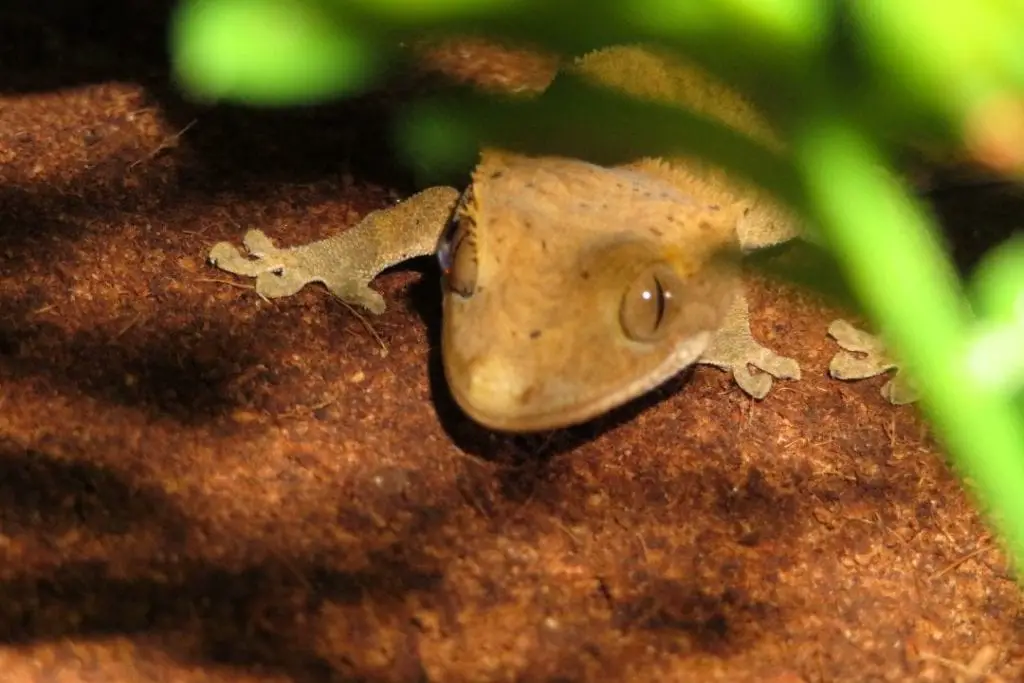
Once you get past the juvenile stage, you will need to select the right substrate for your crested gecko. Loose substrate like Reptisoil is great since it looks good and holds humidity.
You can also opt for a bioactive substrate if you want a fully bioactive enclosure.
A great DIY option is a mix of 60% organic topsoil and 40% coconut fiber bedding.
Newspaper or paper towels are fine for quarantine, but they don’t hold humidity well, and you will have to replace them weekly even if it wasn’t soiled.
Loose substrates can be dangerous for geckos under 12 grams since they can struggle to pass the particles. Adults will be fine so long as they are being cared for properly.
Never use bark, wood chips, coconut fiber, or Eco Earth substrates since these are dangerous if ingested. Any pine or cedar substrate is toxic to reptiles.
Reptile carpet can damage your gecko’s toes. Finally, linoleum and shelf liner can be toxic from off-gassing. Off-gassing can kill small reptiles very quickly.
See my more in-depth article on crested gecko substrates where I compare the pros and cons of each option, including bioactive soils.
Heating Needs
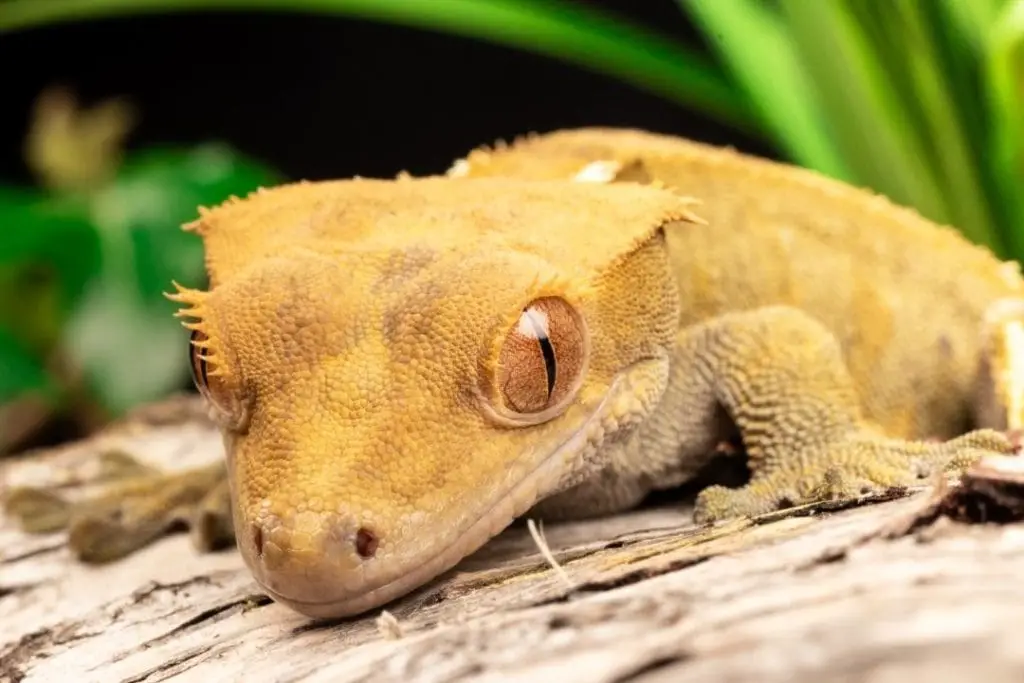
Crested geckos do need heating to thermoregulate their body temperature. The top of the enclosure should be the basking spot, and the bottom should be the cool area.
The heating should be turned off at night. Never let your gecko get above 85 degrees or stay below 70 degrees during the day since these temperatures will harm them.
What is the correct temperature for a crested gecko?
The basking branch at the top should be 82 degrees. The cool bottom of the enclosure should be around 70-75 degrees. It can drop as low as 65 at night, but don’t let it drop any lower. You should have the heating on a timer to turn it off at night.
You won’t be able to fit a heat bulb over a juvenile enclosure. The best option for a baby is to use a small heat mat stuck on the side of the glass at the top.
Use a thermostat with the probe in between the mat and the glass to keep your gecko from overheating.
Adults should use an incandescent heat bulb or ceramic heat emitter for their heat.
A 25w bulb is a good start but you may need more or less depending on your needs. You can use a dimmer to control the temperature. Use a dome housing or a terrarium hood.
Make sure you have a digital thermometer to measure the temperatures in the basking spot and cool area.
You can buy one with two probes or one for each side of the thermal gradient.
You also need a temperature gun for quick checks to verify that the spots your gecko uses are in the right range.
Light
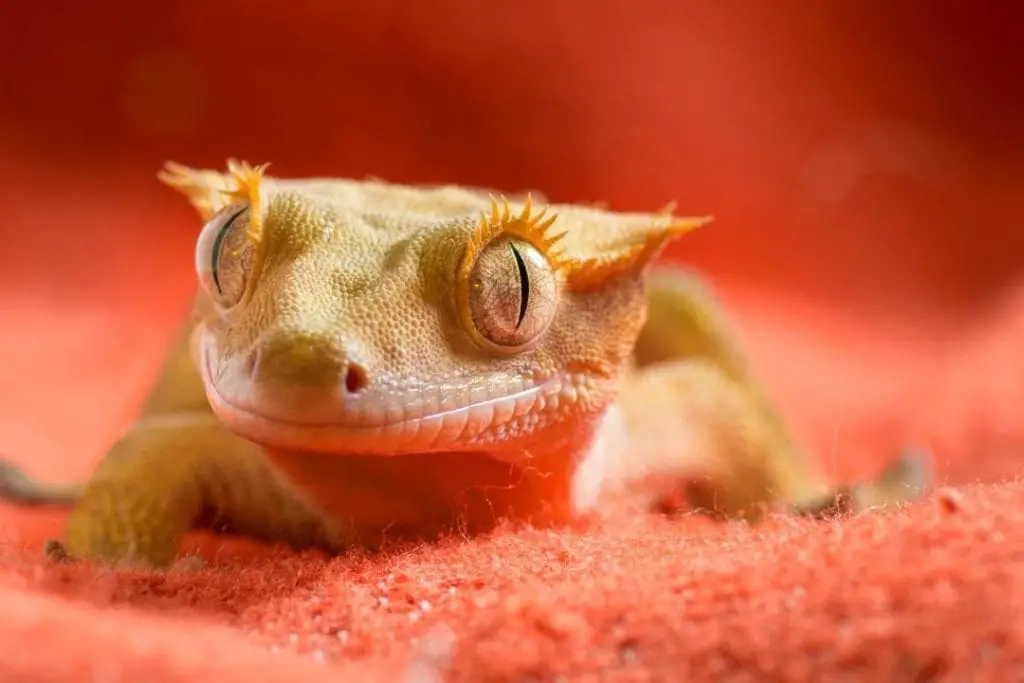
While your gecko will get some D3 from its diet, you should still offer UVB to help keep your gecko healthy.
Since they are crepuscular (similar to nocturnal reptiles), they only need shade dweller bulbs that put out around 5.0 for the UV to reproduce the crested gecko habitat.
Remember that this bulb should be replaced yearly, and never put glass or plastic between the bulb and your reptile since the UV won’t pass through it.
Use a dome housing for it and use a stand for a hatchling to keep the UV from harming your gecko. You can use a hood-style UV bulb for an adult since there is more space. This must be placed between 6 and 8 inches from the basking spot.
You can also use any lighting you like to help you watch your pet. Your crested gecko should have 14 hours of daylight in the summer and 10 hours in the winter to give it proper seasonal cycling.
Use a timer to set this up. Do not leave lights on all night since they can see just fine in an average house.
Colored bulbs should be avoided or only used briefly to see your pets for no more than an hour or you will throw off their circadian rhythms.
Shelter and Design
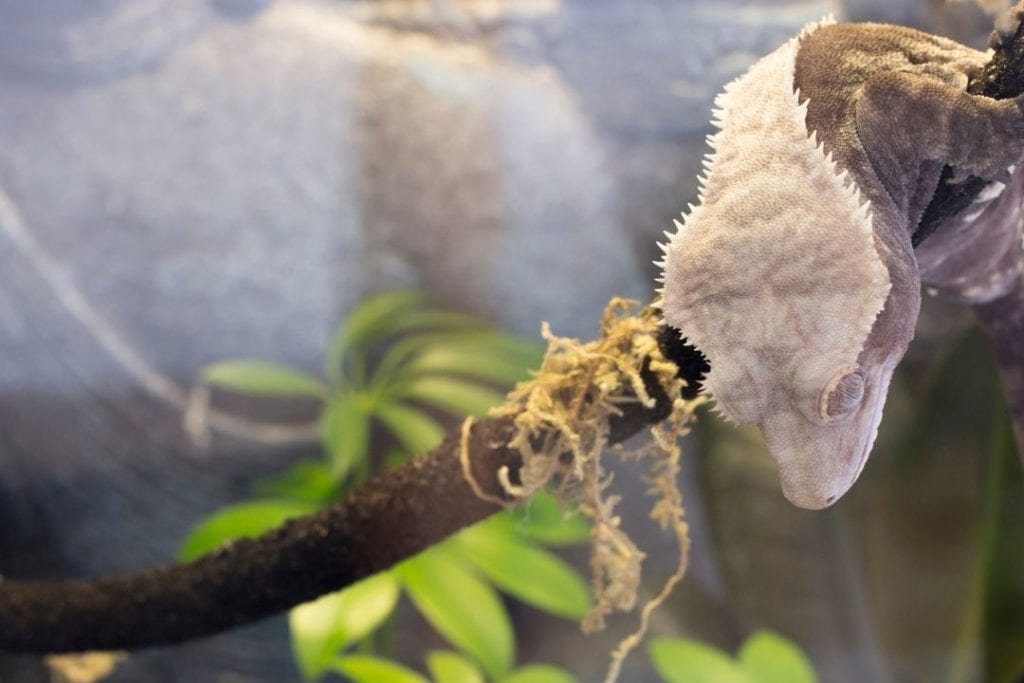
Since crested geckos love to climb thanks to their specialized toe pads, you will want to focus on vertical arrangments.
You will want to focus on vertical surfaces for climbing and jumping, shelter, and places for your gecko to find accumulated water.
Use magnetic shelves for feeding and offering flat resting places. Offer lots of branches and leaves to help give your gecko options for climbing and hiding.
More clutter is better since your gecko will feel safer. Any branches should be secured well to ensure they won’t move and possibly hurt your gecko.
You also want some options for water accumulation since geckos love to drink the condensed water from misting, either from their glass tank surfaces or on leaves.
Live plants work well, but you can always use artificial plants (plastic plants). Look for ones meant for reptiles or safe for outdoor use to make sure they don’t degrade too quickly.
You can also offer cork bark and tubes and birdhouses to offer elevated hiding and climbing places.
Undyed or unpainted bamboo is easy to work with and makes for significant climbing structures; their prehensile tails, and rounded toe pads will love it.
I highly advise watching videos of crested geckos in the wild to help guide you toward a good enclosure design.
Water
Crested geckos get most of their moisture from what accumulates on the sides of the gecko’s tank or leaves after a misting.
Most feeding ledges offer two spaces for cups, so you can place a small gecko cup full of water there to give your pet the option to drink. It is good to offer the option in case your gecko gets thirsty in between mistings.
Humidity
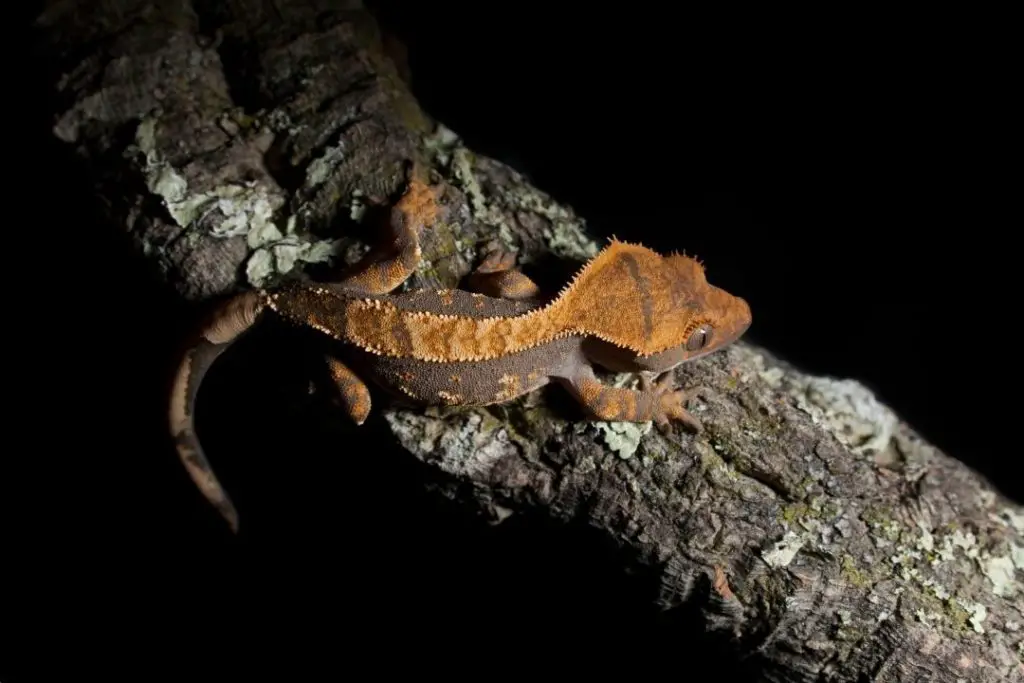
Crested geckos need to be kept between 60-80% humidity. Once you see the humidity drop below 50%, you need to mist.
Letting the enclosure dry just a bit helps prevent mold. You will need to mist at least once a day, but if you live in a dry climate, this may be twice a day.
If you struggle to keep up the humidity, ensure a moisture-retaining substrate and consider switching to a PVC enclosure. Some automatic misters can help.
Use a good digital hygrometer or humidity gauge to monitor your gecko’s enclosure. Most digital thermometers include one.
You need to keep the humidity up to prevent shedding problems and dehydration. Dehydration in your gecko can lead to impaction and many other health problems.
Poor shedding can cause your pet to lose its toes or tail. They may also get an infection from injuries caused by stuck shed. If you see your gecko is going into shed, you should mist it more often.
You can also use dampened sphagnum moss to maintain a higher humidity in their tank.
Enclosure Maintenance
You should replace any water daily and remove any uneaten food daily. Some geckos do prefer their diet to be a bit older, so if you notice your gecko prefers this you can leave it in for a bit longer.
Remove any dried-out prepared diet powder since your gecko will likely not eat it. While you are doing this, be sure to check the temperatures and humidity.
Change these completely once a week if your gecko is on paper towels. You should also clean up any waste if your enclosure is not bioactive.
Once a month, you should take the time to completely clean out the enclosure and change the substrate to prevent bacterial growth.
Turn off any heating and lighting and place your gecko in a holding enclosure. Next, remove uneaten food, remove all furnishings and decor to clean them.
The substrate needs to be thrown away and you should scrub down the enclosure with a reptile-safe sanitizer. Ensure you rinse it thoroughly and let it dry completely before adding a new substrate.
Any furnishings should be cleaned and replaced if you see any signs of damage. Once you have everything cleaned up, you can put your gecko back in and give them time to explore.
Feeding
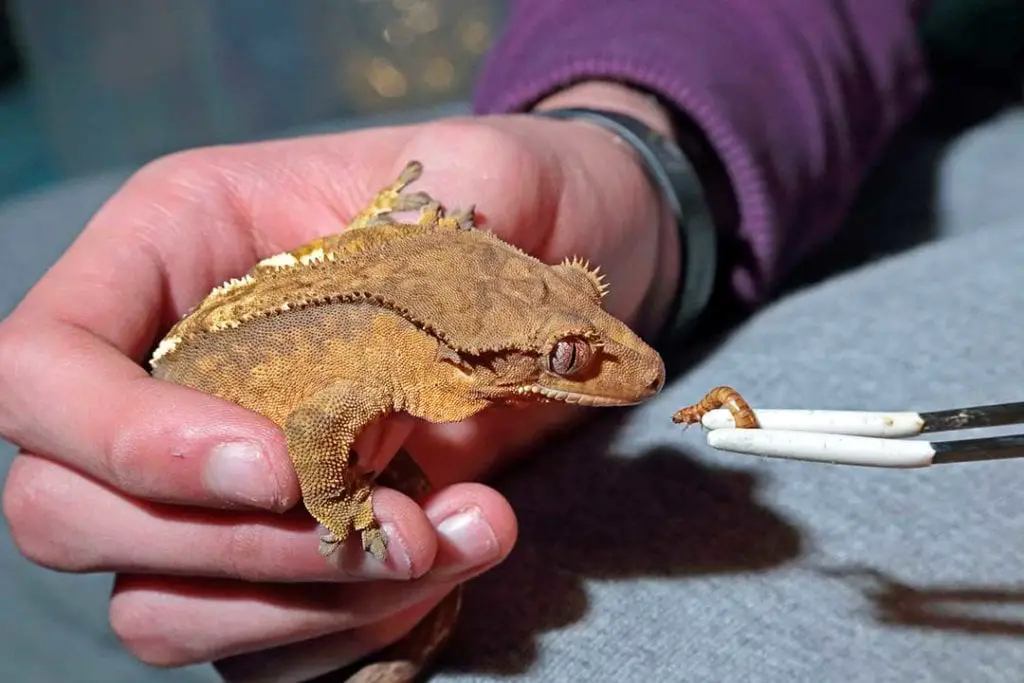
What do crested geckos eat?
In the wild, crested geckos are omnivores. They eat everything from insects, snails, fruit, flowers, nectar, and more. They have a huge diet and will eat nearly anything they can access.
In captivity, the best diet for crested geckos is one of the prepared crested gecko diets that include insects.
Crested Gecko Diet
Crested geckos do have prepared diets available. They are very convenient since they are sold dried and will last a long time.
These diets include the right balance of nutrients for the species.
Zoo Med Crested Gecko Food
- Can be served wet or dry to your scaly sidekick.
- Formulated using the latest nutritional information and techniques.
- May also be enjoyed by day geckos, gargoyle geckos and other omnivorous species.
- Contains probiotics for better digestion, stool consistency, weight management and development.
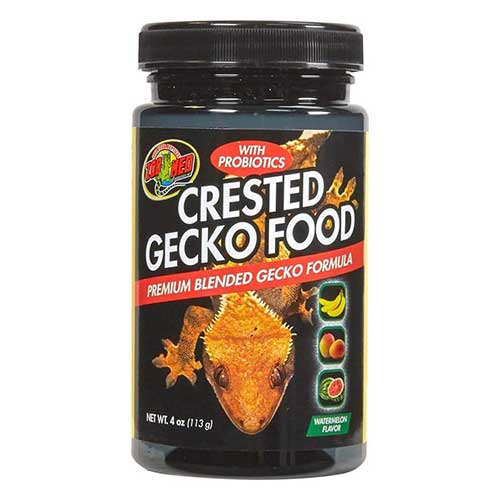
The best brands are Repashy, Arcadia, Pangea, Leapin’ Leachie, Black Panter Zoological, Lugarti, and the new formula from Zoo Med.
Other brands may not have the correct ratio of calcium and phosphorus to keep your gecko healthy.
The diets are easy to prepare and just needs to be mixed with water until it is the consistency of a smoothie or ketchup. This is then offered in a biodegradable gecko feeding cup.
Juveniles are offered the diet daily, while adults are fed with it every other day. Never offer the diet without water since it will draw water from your gecko and make it dehydrated.
You should remove any uneaten diet after a day or so. Different geckos have a preferred flavor and texture.
Ask your breeder which flavor they fed your adult geckos or juvenile to make sure your pet will eat consistently once your pet settles in.
Like other geckos, insects make a good part of the diet, but you must dust and gut-load any feeders to correct the phosphorus level. If you do not add calcium, your gecko may suffer from metabolic bone disease.
Many live insects also have a high fat level, so be careful when feeding adults. Crickets, dubia roaches, black soldier fly larvae, and silkworms are all great choices.
You can feed juveniles insects once or twice a week.
Adults should only get insects once a week. Reduce feeding insects if you notice your gecko is getting fat. If you feed crested geckos with something with a harder body, make sure it is no wider than the distance between your gecko’s eyes.
Supplements and Treats
All geckos need their feeder insects dusted with calcium. If you are offering UVB, do not use calcium with D to maintain a proper care.
If you do not use UVB, you will need to ensure your calcium powder includes vitamin D since your gecko will not make its own.
Treats can include safe insects and fruit for a balanced diet. Good fruits include papaya, bananas, mango, berries, and apricots.
Do not offer this too often or your gecko may refuse to eat its regular food.
Crested geckos also love nectar and pollen like other little lizards. You can always offer this if you can find it.
Some live plants will produce pollen or nectar and you may see your gecko eating this in captivity.
Unsafe Foods
Any insect with high levels of chitin can cause impaction. Beetles are a big culprit as well as their larva.
Do not feed waxworms or super worms to crested geckos. Any wild insect should also be avoided. Do not allow your gecko to eat insects caught in the home.
Baby food is also dangerous for crested geckos. Not only does it typically have preservatives, but the ratios of nutrients are not safe for geckos.
A gecko fed baby food will likely suffer from metabolic bone disease.
Baby food is also more expensive on average than the crested gecko diet. Baby food will go bad long before your gecko can eat it while the diet powders can last for a year or more.
If your crested geckos is refusing to eat, there can be several reasons why. See my article about why you crested gecko is not eating here.
Shedding
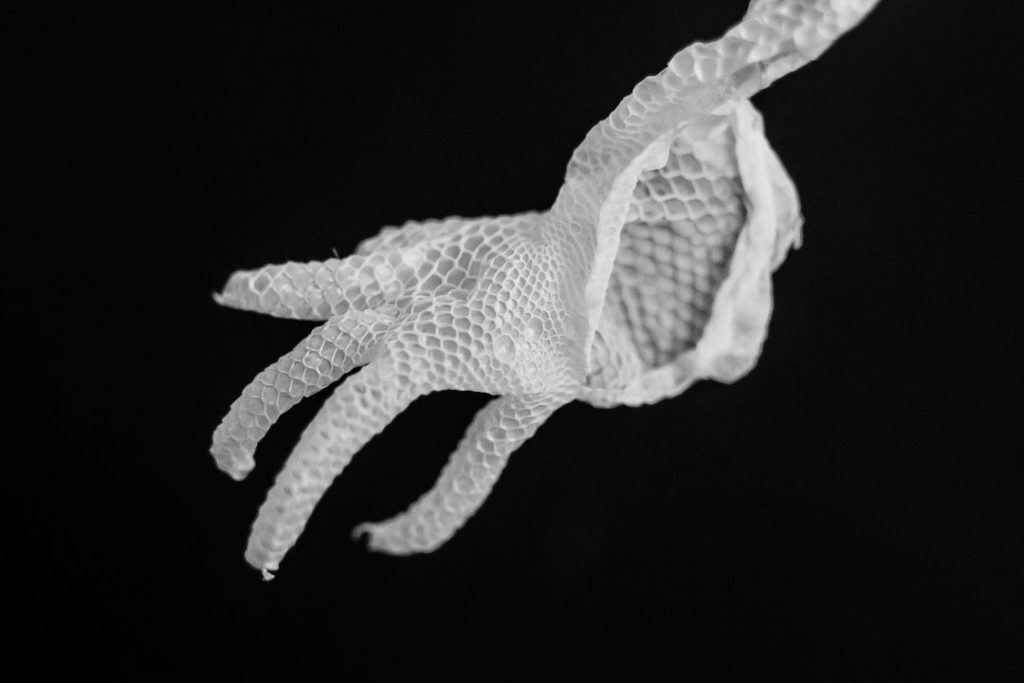
All reptiles shed their skin. This is how they prevent damage to their scales and heal from damage. You will notice your gecko’s color will fade and it may become irritable. Increase the humidity and offer a humid hide filled with damp sphagnum moss.
Once your gecko has shed, you may see it eat the shed skin. This is normal. Once your gecko has finished shedding, check to ensure there is no stuck skin on their toes, tail, chin, and eyes.
Your gecko can be soaked in slightly warm water or placed on damp paper towels to help loosen stuck shed. Do not try to pull off the stuck skin or force it.
like other reptiles, this can cause injuries and infection.
Pay special attention to the feet since many crested geckos get their food on their feet and struggle to shed the skin on messy toes.
Hibernation
Crested geckos in the wild do experience a cooler season. During this time, they stop breeding, will stop eating and will be less active.
You do not need to cool down your crested gecko in captivity. It can be helpful for breeding, but it isn’t necessary.
Breeding
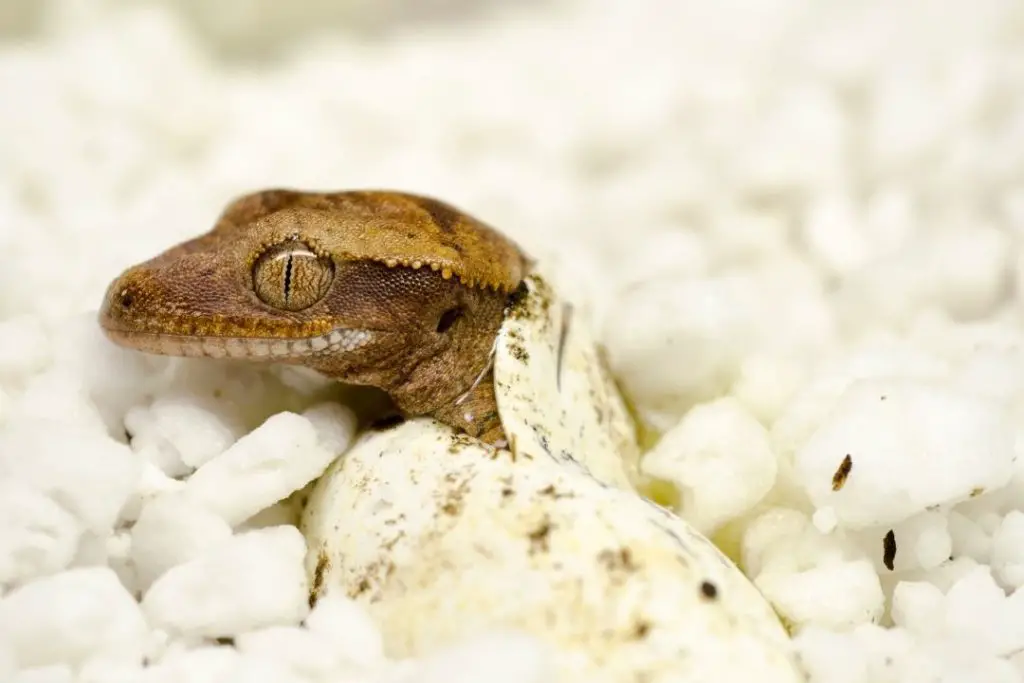
Breeding crested geckos is fairly easy. They will readily breed once they reach adulthood. You should wait until your geckos are both over 1.5 years and have reached about 30 grams of weight so they are sexually mature.
You can house a male with up to 3 females, but conflict is likely and you will need to have separate enclosures ready for all adults.
You can easily introduce your male into the female’s enclosure and watch them. You may not see them breed, but you look for conflicts like tail-biting and other injuries.
Once your geckos mate, the female can keep laying for the year from only one mating.
You should use a lighter layer of substrate and offer her a lay box filled with peat moss or a similar substrate that allows your gecko to dig.
You want her to lay in the box or you risk accidentally damaging the eggs if she has them hidden somewhere in the enclosure.
Once she lays, you will want to move the eggs to an incubation box with a hatching medium in it. Incubate at 68-74 degrees environmental temperature to help make sure your hatchlings are larger and more likely to eat well.
Incubation time varies, but remember to never cut eggs unless the baby is trying to cut open the egg and is struggling to make a large enough hole.
Female geckos can produce up to 16 babies in one breeding season, so you need that many baby enclosures. A plastic shoebox-type box with added ventilation works well.
You can use paper towel tubes, toilet paper rolls for hides, and crumpled-up paper towels to offer cover. Babies should be kept on paper towel substrate and in easily sanitized housing to make sure they stay healthy.
You can sell babies once they are eating regularly, but they should weigh over 2 grams.
Handling
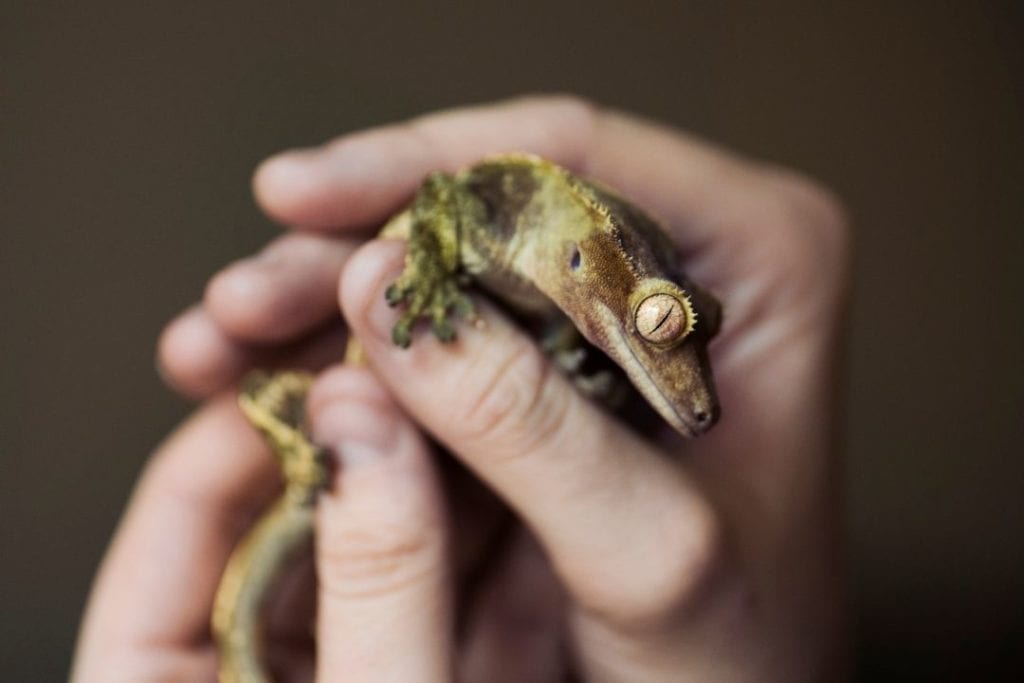
You need to wait for at least 2 weeks after acquiring your crested gecko before you can start handling it. Ideally, wait until it is eating regularly.
Make sure you handle your gecko over a soft surface since they will jump and can be hurt.
Stick with handling your gecko for 5 minutes no more than 3 times a week until it learns you won’t hurt it.
Then you can increase handling times.
Never keep your gecko out for more than 20 minutes a day even if they seem to tolerate it. If your gecko is flighty, you can let them hop between your hands until they calm down.
Remember that crested geckos are nocturnal so it is best to keep handling sessions for evening and night time.
Frequently Asked Questions
Here are some basic questions you may have. If yours isn’t answered, you can ask in the comments below.
Do Crested Geckos Like to be Held?
They can enjoy exploring. Many crested geckos like spending time with their human and getting to see new things. Just make sure you do not stress your pet.
Does a Crested Gecko Make a Good Pet?
Crested geckos make great pets since they are calm and easy to care for. They can be delicate since they are small.
How Hard is it to Care for a Crested Gecko?
Crested geckos are really easy to care for. The hardest part tends to be keeping up humidity.
How Big do Crested Geckos Get?
An adult crested gecko will be 6-10 inches long with a tail and 30-60 grams. Without a tail, they are around 5-6 inches long.
Do Crested Geckos get Attached to Their Owners?
Crested geckos are not social animals, so they do not really feel love like we do. They can trust you and frequently will pick a favorite human out of humans they trust.
Are Crested Geckos Friendly?
Crested geckos are friendly for lizards. They can be a bit flighty, but they love new experiences and a chance to see new sights.
Is it Easy to Care for a Crested Gecko
Crested geckos are among the easiest geckos to care for. They are small, have easy care requirements, easily available food, and tend to be healthy.
The main trouble with the species is that they make blind jumps and can be hurt if they hit a hard surface.
How long does a crested gecko live?
On average, a pet crested gecko will live to be 10-20 years old. They were only introduced to the pet trade in 1994, so it is unknown what the true average crested gecko lifespan is at the time of writing.
Where to Buy a Crested Gecko?
You can easily find a crested gecko at a reptile expo near you or find a breeder online at places like Morph Market. If you buy online, look at reviews and ask questions. Geckos should be alert and in good condition in person.
Prices will vary, see my article about how much crested geckos cost here.
Sources
- Rhacodactylus ciliatus : Crested Gecko, Eyelash Gecko – ADW
- Marquette study finds crested geckos have developed sticky tail pads
- New Caledonian Crested Gecko – Bowling Green State College of Science
- Thermoregulation and thermal performance of crested geckos (Correlophus ciliatus) suggest an extended optimality hypothesis for the evolution of thermoregulatory set-points
- Dominance in Female Crested Geckos (Correlophus ciliates)
- Robbie, Hamper (2003). The crested gecko, Rhacodactylus ciliatus, in captivity. Lansing, Mich.: ECO Publishing.
- Crested geckos breeding basics – acreptiles
Conclusion
Crested geckos are an easy beginner species for reptile keepers so long as you follow their care.
Make sure your pet sees a vet yearly and they should be a healthy crested gecko for up to 20 years.
I hope this crested gecko care sheet was helpful 🙂 I tried to cover everything, but if I missed something or if you have any questions please leave a comment below!
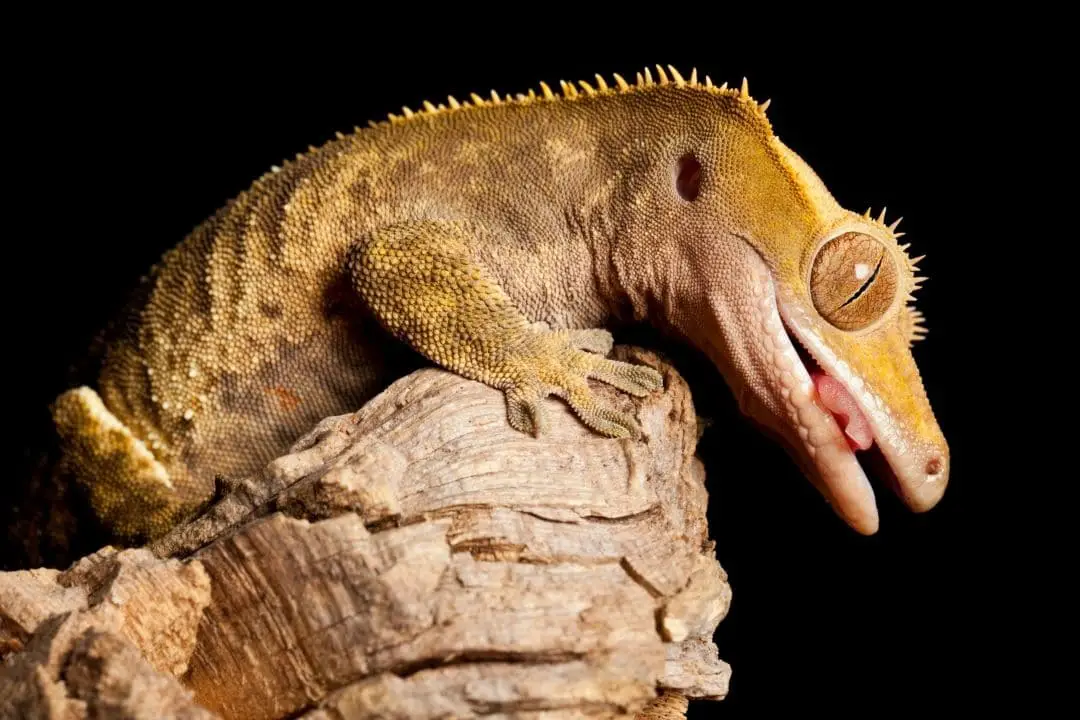
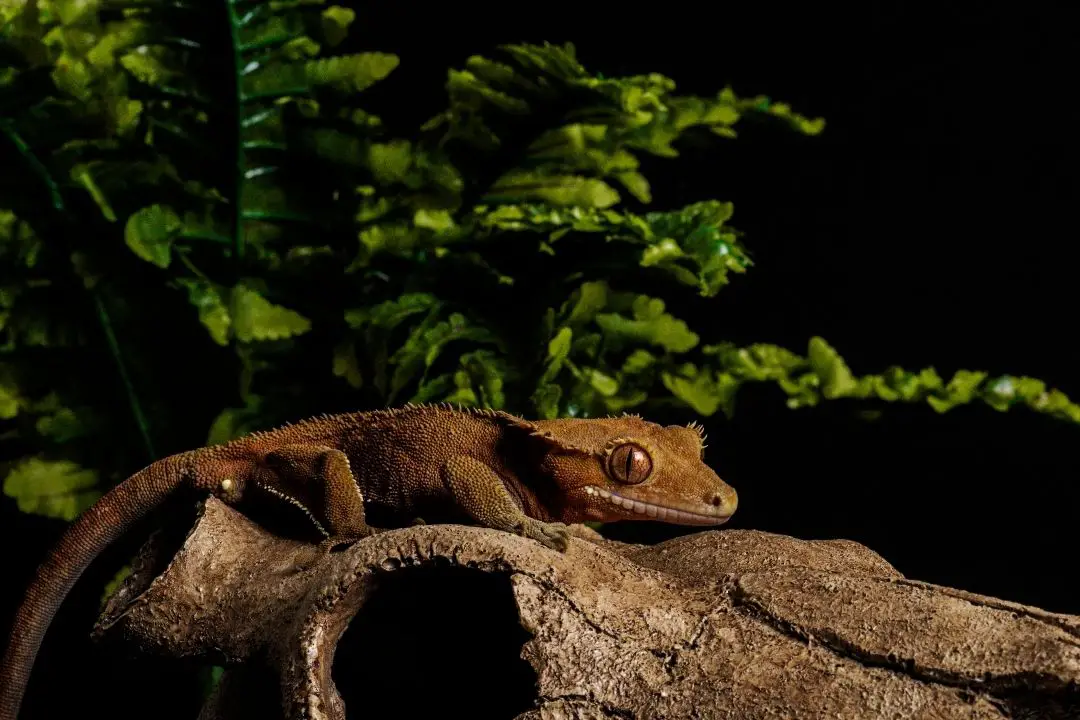
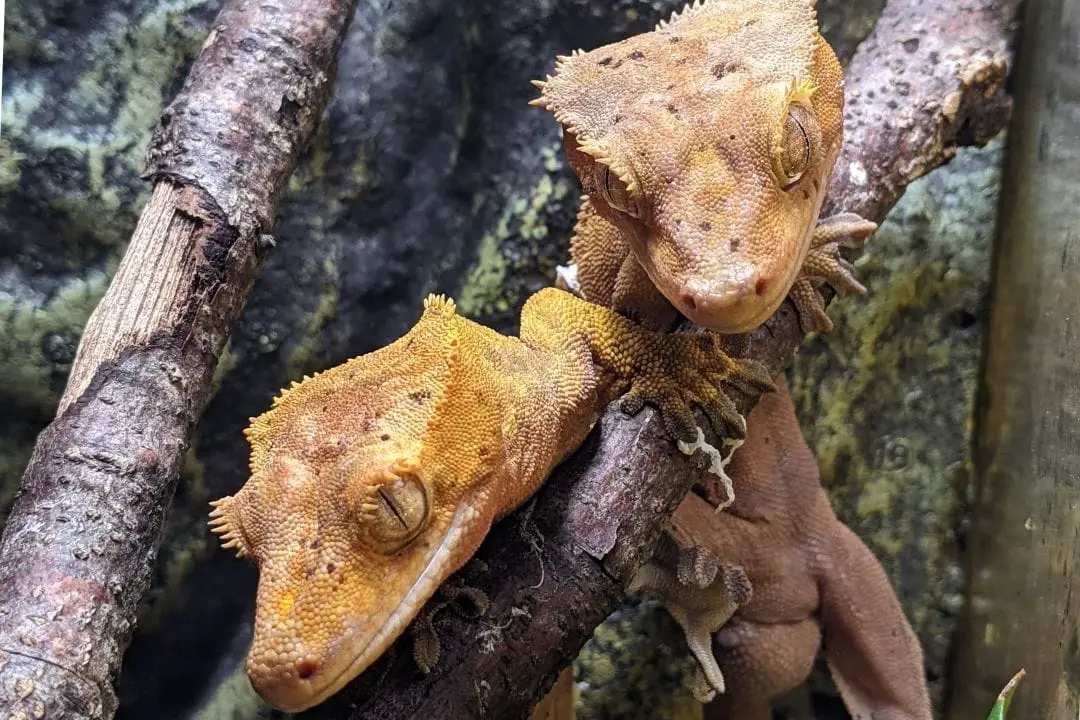
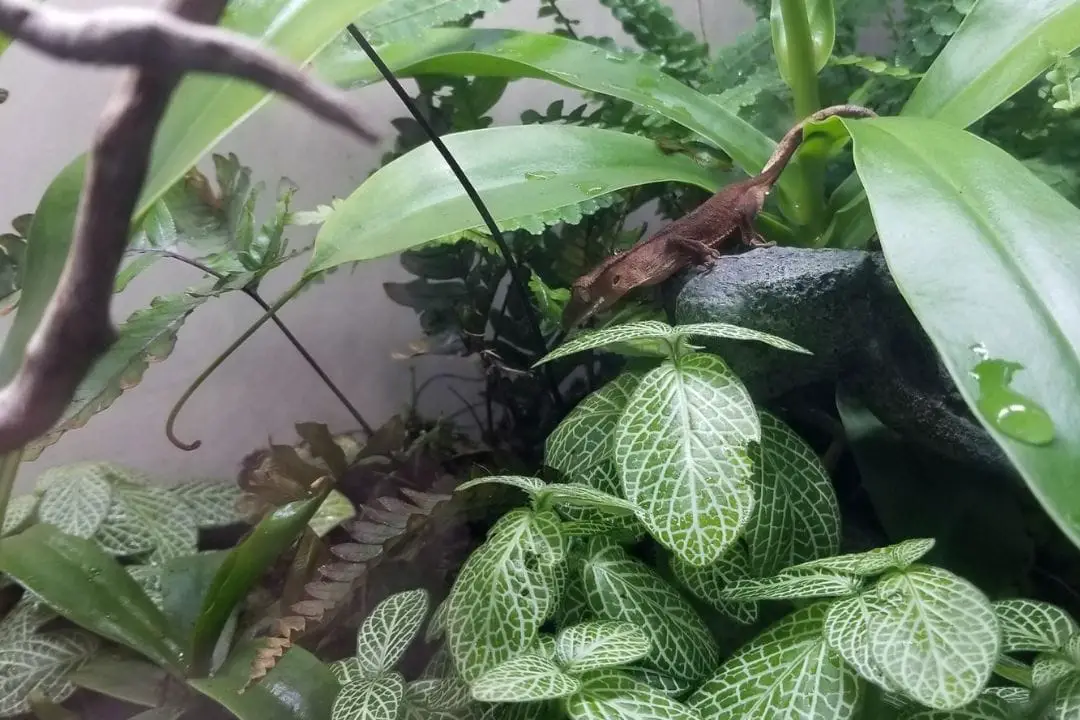

Great share! Very comprehensive guide for crested gecko owners.